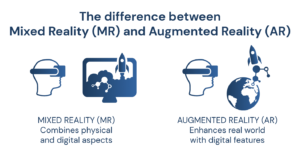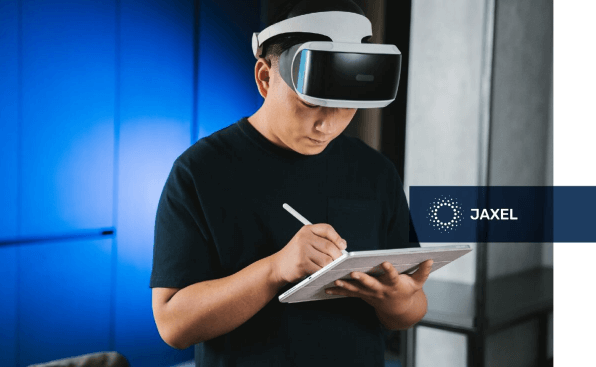What Are VR, AR, and MR?
Virtual reality is a completely virtual world. An augmented reality environment is a physical environment that has been covered with virtual items. MR is a combination of a real-world environment.
Virtual Reality (VR)
Virtual reality creates an entirely immersive environment that separates the client from physical world. Utilizing virtual reality devices like the HTC Vive, Google Cardboard, or Oculus Rift, consumers can be transported into a range of real-world or imagined realms, like the middle of a cawing penguin community and even the back of dragons.
Augmented Reality (AR)

In augmented reality, digital information is placed on real-world objects. Pokémon GO* is one of most well-known examples. Although augmented reality keeps the concentrate on the real world, it enhances it with digital features, adding new levels of perception and increasing your reality or surrounds.
Mixed Reality (MR)
MR combines physical and digital aspects. You may interact with and alter both physical and virtual items and environments in mixed reality by utilizing next-generation sensor and imaging technology. Without removing your headset, mixed reality enables you to watch and be immersed in your surrounding area while engaging with a simulated environment using your own hands.
How does Mixed Reality Differ From Augmented and Virtual Reality?
Mixed reality is identical to augmented reality since it does not remove you from your surroundings but instead reads them and magnifies them with digital items. However, unlike augmented reality material, which can be accessed via a mobile device, mixed reality requires the use of a headset.
Despite the use categories for MR and AR may overlap, mixed reality may enable better interactivity with digital material to some extent since users can go hands-free; and have no need to keep onto a Smartphone to keep it running. It is, however, what limits its appeal to the broad market. While it is believed that over 5 billion people worldwide use mobile devices, the same cannot be said for magnetic resonance glasses, which are still in their infancy and rather expensive.
However, there really is no doubt that MR holds enormous promise. There are still several hardware/software upgrades required to execute the theoretical notions held by individuals, but they are just a question of time.

What Is Interactivity In Virtual Reality, Augmented and Mixed Reality?
Interactivity in virtual reality
When discussing virtual reality, the term “interactivity” refers to the unique interactions developed between both the digital model and its users. It denotes the potential of the user participating in the computer-mediated information transfer procedure. Therefore, a medium becomes interactive if it enables the user to shape the communication’s contents or form.
There are many degrees of interaction: the lowest level enables the user to choose information; the intermediate level enables users to produce or insert material, and the highest level causes the virtual world to respond correctly to the user’s input.

Interactivity in augmented reality
Interacting with virtual objects and presenting them inside the actual world is what is meant by the term “interactive augmented reality.” A 3D jigsaw puzzle-solving system I’ve developed allows staff to collaborate together in different locations while using interactive augmented reality technology to help them complete the problem.
This system was built on the Vitoria platform utilizing the Unity3d engines. Because of their ease of use, good camera quality, and ability to show augmented reality apps, Apple’s tablets were chosen for the project. According to the findings, two people may work together to complete tasks in an augmented reality world by lending a hand.
Interactivity in mixed reality
In a mixed reality world, interactive narrative combines physical and digital details and information. It often enhances real-world and physically-based interactivity in order to create an immersive environment that matches the dramatic plot of the interactive storytelling, which is modified by the user’s actions.
Immersion is a critical component of such an exhibit, and it may be impacted by a variety of aspects, including video, sound, interactivity, and, eventually, the intensity of all integrated stimuli. We used many of the phases from our interactive ALICE exhibit to examine immersiveness and the aspects that contribute to it in a between-group design, with a particular emphasis on the impact of interactivity and the environment’s input and feed forward stimuli on consumer experience.

Usability of VR, AR, and MR VR Uses/Applications
1. Development and learning
The learning and development business is beginning to embrace VR, with companies like as Virtual Speech offering virtual reality teaching for soft skills. As a result of their engagement with corporations, they’ve been able to integrate corporate training into their current LMS. It lowers the cost of training and increases student retention at the same time.
2. Gambling
Poker VR, a virtual reality poker game, lets you play with up to four other people in real-time. If you’ve ever wanted to play at a genuine casino, here is the best way to do it. They currently have such a prize pool of $5000 in prizes.
3. Architecture
Architectural design and experimentation are being transformed by virtual reality. Virtual reality (VR) allows you to visualize not just how a structure or area will look, but how it will feel, as well. Architects and customers may save both time and money by allowing homeowners to view the space before it is created and making real-time alterations.
Immersive solutions like Iris VR allow architects to comprehend and experience the area to the fullest extent feasible.
4. Real estate
You don’t have to hire an agent or give up your weekend to look at houses when you can do it from the comfort of your [current] home. People can look at properties online and only go see the ones they think they’ll like in person. More than a thousand residences have been surveyed utilizing Matter port’s scanning technology.
5. Tourism
Why not test your vacation before you buy it? That is exactly what the future may bring. Virtual visits of hotels, restaurants, and tourism attractions are being developed by the business.
6. Automotive industry
A vehicle’s look and construction can be swiftly experimented with before expensive prototypes are ordered by engineers and designers. Using virtual reality, automakers like BMW and Jaguar Land Rover are already testing the visual look and object obscuration of their vehicles before any money is spent on building the elements physically.
AR Uses/Applications
- Design and modeling
- Repair and maintenance
- Retail
- Medical training
- Business logistics
- Public Saftey
- Entertainment properties
- Field service
- Classroom Education
- Tourism industry
MR Uses/Applications
- Education
- Holograms
- Training
- Sports
- Engineering
- Healthcare

Benefits of AR and VR
Usability in Virtual Reality, Mixed Reality and augmented reality are all revolutionizing our perception of reality. To put it more simply, virtual reality is a world created solely by computers. It is a realistic reproduction of a computer-generated environment. This virtual environment is mostly experienced by the user through visual and auditory cues. In a virtual realm, everyday reality is completely obliterated.
On the other hand, augmented reality is formed by superimposing computer-generated components on top of existing physical reality. It establishes a digital layer on top of the physical environment. Virtual Reality recreates aspects of the physical world in a virtual context. Whereas augmented reality incorporates parts of the digital world into the physical world.
Benefits of MR
- Its immersive and interactive nature enables the user to acquire and remember more information; Anyone can share your thoughts in real-time with other people over great distances;
- Reduces the complexity of complicated processes by simplifying and streamlining them;
- It can assist you in gaining a competitive edge by collecting and contextualizing data.









